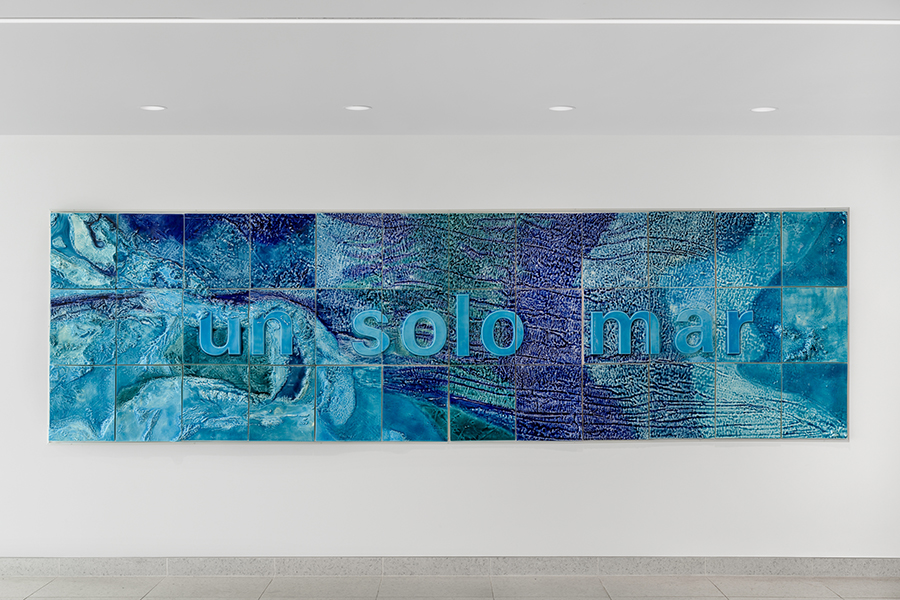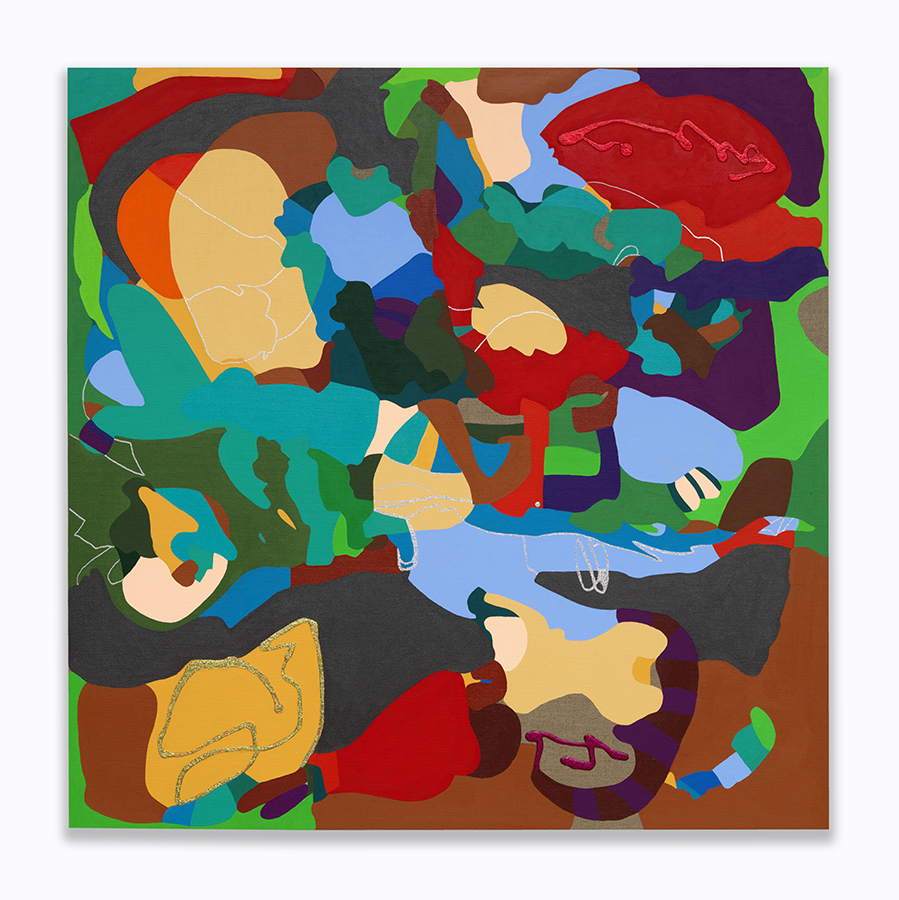Adriana Zavala
Latinx Unsettling

Juana Valdés, The Deepest Blue, 2023, 36 ceramic panels, overall: 50 × 175 × 3 in., Cruise Terminal F, PortMiami, courtesy of the Miami-Dade County Art in Public Places Trust. Photo: Zachary Balber. This artwork is part of the collection of the Miami-Dade County Art in Public Places program, made possible with the support of the Art in Public Places Trust, the Miami-Dade County Department of Cultural Affairs and the Cultural Affairs Council, the Miami-Dade County Mayor and Board of County Commissioners.
During my second year as the Andrew W. Mellon Professor, I completed final revisions of “X as Intersection: AfroLatinx Art,” a chapter in The Routledge Companion to African Diaspora Art History, edited by Eddie Chambers, slated for publication in fall 2024. The essay offers a close reading of five artists—Carlos Martiel, Alan Pelaez Lopez, Shellyne Rodriguez, Yelaine Rodriguez, and Juana Valdés—exploring how their works unsettle normative historical frameworks and structural racism, while also expressing intersectional empathy. In conceptually complex and aesthetically diverse ways, these artists insist that we acknowledge how antiblackness operates historically and still today within and beyond the Latinx community. The term Latinx was coined by trans* and LBGTQIA2+ activists in the early 2000s as a genderqueer alternative to Latino/Latina, used to describe people of Latin American and Hispanophone-Caribbean descent who live and work in the United States. As a political concept, the term Latinx brings visibility to people marginalized within heteronormative and whitewashing frameworks, and it envisions justice. The essay thus explores Latinx as a political and theoretical framework rather than a multicultural identity category, as has been claimed by detractors and by the neoliberal establishment alike. Instead, the x insists that we acknowledge how oppression and inequality are experienced as interlocking forces by queer, trans, femme, Black, and Indigenous members of our community. Taking inspiration from the artists considered, the essay issues a call to action: only by centering Black experiences and creativity can we begin to unsettle whitewashing formulations of the Latin American Diaspora and fully actualize the coalitional, relational, and emancipatory possibilities of Latinx studies and methods. In addition, the essay offers readers a provisional list of artists for further consideration (which is admittedly already incomplete!).
I also continued research on the collaborative curatorial projects undertaken from the early 1980s through the 1990s by three pioneering Latinx artists: Cuban American artist Ana Mendieta (1948–1985), Nuyorican artist Juan Sánchez (b. 1954), and Chicana artist Amalia Mesa-Bains (b. 1943). Curated for alternative art spaces in New York City, San Francisco, and Santa Fe, these exhibitions reveal the rich landscape of cross-group solidarity that Mendieta, Sánchez, and Mesa-Bains activated, particularly with African American and international artists who identified as Third World, that is in solidarity with postcolonial and/or nonaligned Cold War–era political and social struggles. By studying these exhibitions, I aim to unsettle assumptions about the insularity of artists of color, demonstrating instead how they cultivated a crosscutting international community that engaged intensely with the concept of art as social practice and with aesthetics simultaneously. Their creative approaches are irreducible conceptually and formally, and these exhibitions, both in theme and the range of artists included, demonstrate how Mendieta, Sánchez, and Mesa-Bains never worked in siloed isolation. Instead, they were fully ensconced in alternative art scenes that fueled creative innovation in response to urgent political issues.

Candida Alvarez, Flor de Caballo, 1, 2022, acrylic on linen, 121.9 × 121.9 cm (48 × 48 in.). Image courtesy of the artist and Monique Meloche Gallery
In December, I had the pleasure of seeing the 30-year career retrospective of Juana Valdés (b. 1963), Juana Valdés: Embodied Memories, Ancestral Histories (October 22, 2023–February 11, 2024), at the Sarasota Art Museum. I was commissioned to write a short-form essay on the exhibition and Valdés’s work, which appeared in the free online journal Intervenxions, published by the Latinx Project at New York University. The essay explores how Valdés’s creativity springs from her incisive understanding of the legacies of colonialism’s racial violence, particularly for women of color. Working across printmaking, photography, ceramics, installation, and video, Valdés’s elegant and materially rich works thematize the materiality of memory in relation to the history of the global migration of enslaved people and contemporary migrants alike. Her works evoke how Diasporic people are both tethered and untethered to ancestral lineages while also meditating on her experience as a Black Latinx woman making her way through the still largely male-dominated and monocultural art world, and demonstrating her deep engagement with thinkers and artists as varied as Barbadian writer Kamau Brathwaite, Cuban dissident writer Reinaldo Arenas, and postwar German artist Joseph Beuys. Moving on to Miami, I sought out Valdés’s latest work, The Deepest Blue, which was unveiled in November at PortMiami and forms part of the collection of the Miami-Dade County Art in Public Places Trust. The work is a large-scale ceramic mural comprising 36 brilliantly glazed tiles in shades of blue-green. The topical relief mural was created using various digital technologies to map the contours of the ocean floor between the Ivory Coast and the Caribbean. The Deepest Blue is thus a metaphorical exploration of the complex terrain of Afro-Diasporic identity and a memorial to those transited and those who perished on the Middle Passage (communicated to me by Taylor Bradley, Valdés’s studio assistant; see also “Juana Valdés: The Deepest Blue.”) The work’s subtitle, “un solo mar,” invites us to immerse ourselves in this complex history and seek “unity in the submarine,” to quote Kamau Brathwaite.
Along with these projects, at present I am delving into the work of contemporary Nuyorican abstract painter Candida Alvarez (b. 1955), writing a commissioned essay that will appear in the catalog of the artist’s upcoming retrospective at El Museo del Barrio in New York. Alvarez’s collage-like paintings are both intuitive and informed by personal experiences, memories, and happenstance encounters that she records photographically and then translates into carefully balanced interlocking structures of color, shape, and line.
Lastly, during this second year of my fellowship and in my role as executive director of the US Latinx Art Forum (USLAF), I designed a new public humanities initiative—X as Intersection: Writing on Latinx Art—that will commission short-form essays about the 45 visual artists who have thus far received USLAF’s Latinx Artist Fellowship. I serve as the initiative’s executive editor in collaboration with a brilliant team of colleagues on the editorial board: Kency Cornejo, Karen Mary Davalos, Elizabeth Ferrer, Tatiana Flores, Josh T. Franco, and Mary M. Thomas. The initiative is designed to support visual artists by commissioning informed, analytical, and multi-genre writing on their work while also fostering a community of writers engaged with Latinx art and art history.
Tufts University
Andrew W. Mellon Professor, 2022–2024
In July, Adriana Zavala will be formally promoted from associate to full professor in the Department of the History of Art and Architecture.
